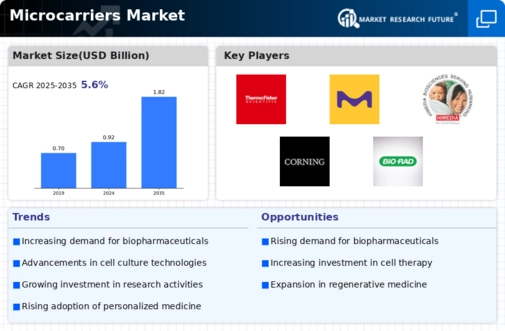Market Analysis
In-depth Analysis of Microcarriers Market Industry Landscape
The microcarriers market dynamics are shaped by a myriad of factors influencing its growth trajectory and evolution. At its core, the demand for microcarriers is primarily driven by the expanding biopharmaceutical industry and the growing adoption of cell-based therapies. Microcarriers serve as a critical component in the production of biologics, vaccines, and cell therapies by providing a supportive environment for the growth and expansion of adherent cells. With the rising prevalence of chronic diseases and the increasing emphasis on personalized medicine, there is a growing need for efficient and scalable cell culture systems, driving the demand for microcarriers.
Additionally, advancements in bioprocessing technologies and the shift towards automated manufacturing processes are fueling market growth. Biopharmaceutical companies are increasingly investing in process optimization and automation to enhance productivity, reduce production costs, and ensure consistent product quality. Microcarriers play a crucial role in enabling scalable cell culture processes, allowing manufacturers to achieve higher cell densities and production yields while streamlining manufacturing workflows. As a result, there is a growing demand for innovative microcarrier products that offer enhanced performance, versatility, and ease of use.
Moreover, the market dynamics of microcarriers are influenced by regulatory frameworks, quality standards, and industry best practices. Regulatory compliance is a key consideration for biopharmaceutical manufacturers, as they are required to adhere to stringent guidelines and standards to ensure the safety, efficacy, and quality of their products. Microcarriers used in cell culture applications must meet regulatory requirements for biocompatibility, sterility, and purity, driving the demand for high-quality, cGMP-compliant products. Manufacturers that demonstrate compliance with regulatory standards and provide robust quality assurance systems are better positioned to capitalize on market opportunities and gain customer trust.
Furthermore, market dynamics are shaped by competitive forces, with numerous companies vying for market share through product differentiation, innovation, and strategic partnerships. Established players in the microcarriers market leverage their technical expertise, manufacturing capabilities, and global distribution networks to maintain a competitive edge. They invest in research and development to introduce novel microcarrier formulations, surface coatings, and functional modifications that enhance cell attachment, proliferation, and differentiation. Moreover, strategic collaborations between microcarrier manufacturers and biopharmaceutical companies enable joint product development, customization, and validation, fostering innovation and market expansion.
The evolution of cell therapy and regenerative medicine is also driving market dynamics, as these emerging therapeutic modalities hold immense promise for addressing unmet medical needs and revolutionizing disease treatment. Microcarriers play a crucial role in the scalable manufacturing of cell-based therapies, enabling the production of large quantities of therapeutic cells for clinical applications. With the growing interest and investment in cell therapy research and development, there is a corresponding increase in demand for microcarriers tailored to specific cell types, culture conditions, and therapeutic applications.
Despite the promising growth prospects, the microcarriers market faces certain challenges and uncertainties that may impact its trajectory. Market consolidation, pricing pressures, and supply chain disruptions pose challenges for smaller players and new entrants, limiting their ability to compete with larger, more established companies. Moreover, concerns regarding product quality, consistency, and scalability remain key considerations for biopharmaceutical manufacturers, driving the need for robust quality control measures and manufacturing processes.








Leave a Comment